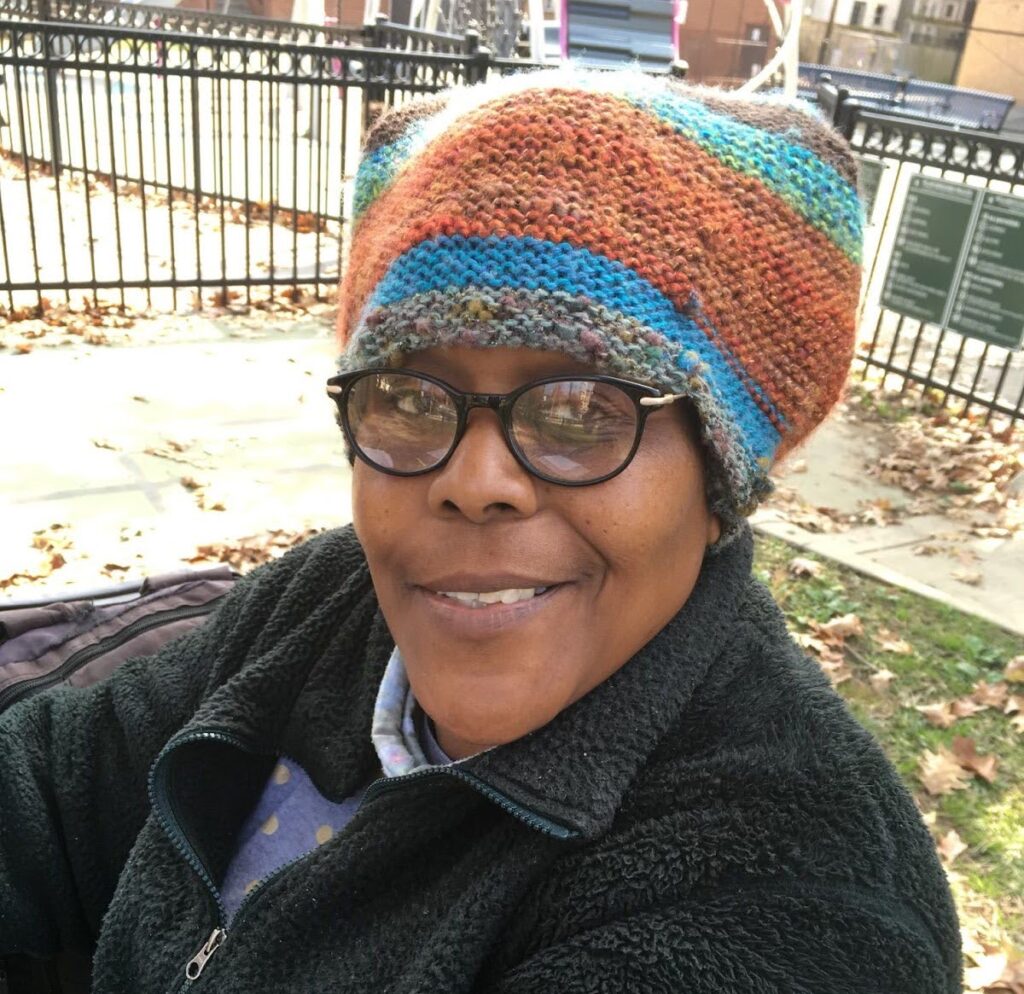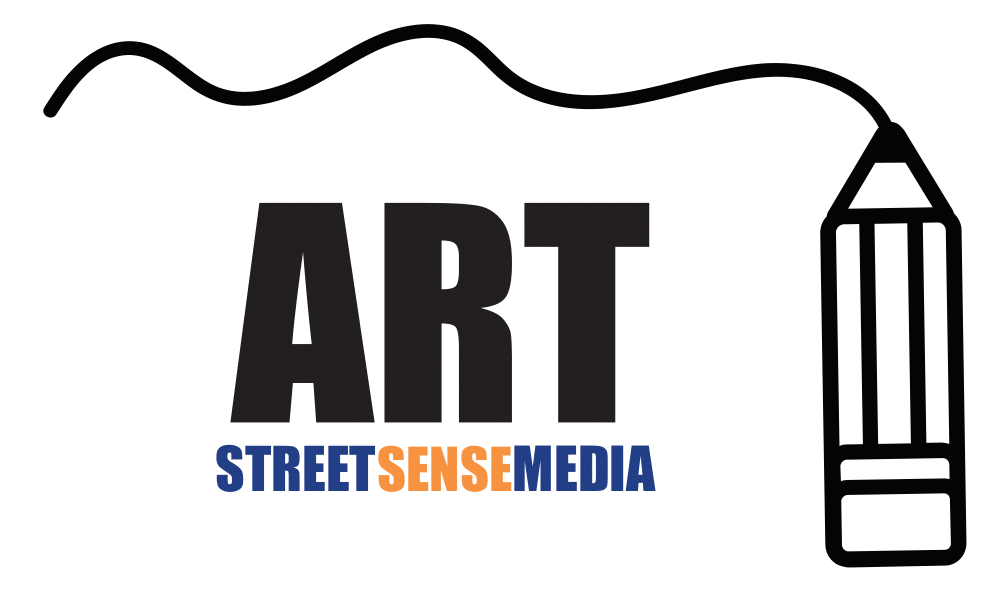Last month, the convergence of the International Day of the World’s Indigenous Peoples with the release of a dire Intergovernmental Panel on Climate Change (IPCC) report created the natural groundwork for the Seattle-based Indigenous advocacy nonprofit Nia Tero to launch its latest media campaign. “Thriving Peoples, Thriving Places” seeks to secure Indigenous guardianship of vital ecosystems through global activism.
Six original portraits of Indigenous women leaders were commissioned for the campaign from D.C.-based artist and former Street Sense Media volunteer Tracie Ching. In addition to online access where the artwork is free to download, Ching’s posters are being displayed in five cities worldwide: Seattle, New York City, London, São Paulo, and Washington, D.C. In addition to the portraits, the series includes typographic posters made up of words and phrases like “Justice,” “Collective humanity,” “Global wisdom,” “Powerful,” and “Amplifying matriarchs.” They have appeared in temporary “stunts,” including digital mobile displays, as well as in semi-permanent capacities such as mural-size installations and walls covered in the various posters.
The project’s global outreach aims to bring Indigenous leaders to the forefront of humanity’s fight against climate change, which the IPCC report said has occurred at an “unprecedented” pace and is due “unequivocally” to human influence.
Displaying the faces of Indigenous activism and resistance on an international stage is essential for the recognition of their continued contributions to safeguarding essential ecosystems, according to Nia Tero’s creative producer Jessica Ramirez. Thriving People’s, Thriving Places is the second collaboration between her organization and the art activism nonprofit Amplifier.
In preparation for the campaign’s release, activists with Nia Tero showcased the digital portrait of Indigenous Filipina activist Vicky Tauli-Corpuz in front of the U.S. Capitol during the weekend of July 23. “The whole point was to bring these powerful images in front of iconic D.C. institutions as recognition of the value that these Indigenous leaders bring to the table,” Ramirez said.
D.C. was a particularly important staging ground for the campaign, as leaders in the nation’s capital continue to say Indigenous land rights and climate change are important while implementing policies that harm both. On April 22, the Biden administration led a virtual climate summit with 40 world leaders. However, the president’s previous promises to address the concerns of Indigenous leaders and tribal governments rang hollow when the Biden administration said in a court filing that it would not shut down the Dakota Access Pipeline.
Years of Indigenous-led protests in D.C. and across the country have opposed the Dakota Access and Line 3 pipelines, which most recently included a march through Chinatown in April and an August protest outside the National Museum of the American Indian. Meanwhile, the lack of a substantive response from politicians reaffirms the dissonance between rhetoric and policy decisions.
“Climate change is not going anywhere until we address it from an Indigenous lens and we hope that this campaign builds traction over time and its relevance will continue to be there as long as decision makers don’t do what it takes in order to support the [Indigenous] leaders who have the solutions to these problems,” Ramirez said.
The Nansemond Indian Nation in Southern Virginia, through the leadership of Assistant Chief and Environmental Program Director Keith Anderson, has made Indigenousled campaigns to protect the local ecology a top priority in the protection of Virginia tribal territories. According to Anderson, the Nansemond River and its distributaries, which run through Nansemond Indian Nation territory, make up one of the most contaminated river basins in Virginia and are fit for neither recreational use nor human consumption. “To help combat that we have started an oyster preservation project … to help improve the water quality, filter the waters and bring back a healthier ecosystem,” Anderson said.
The harvesting of oysters has been a central component to the Nansemond way of life for centuries and their preservation, through the Chesapeake Oyster Alliance, is a perfect example of addressing environmental degradation through an Indigenous-led strategies. However, decades of hard-fought advocacy on behalf of Indigenous land sovereignty have only recently ended in legislative victories that recognize the mere existence of local Indigenous tribes. In 1985, the Nansemond Indian Tribe gained state recognition and in 2018, the Nansemond people were finally recognized at the federal level.
Furthermore, the enacted legislation has not always been enforced. The tribes of Southern Virginia have been unified in their fight to uphold the Native American Graves Protection and Repatriation Act, which states that land developers that come across human remains must stop their work immediately. “Through a lot of the destruction and development that’s going on in Virginia, there have been a significant amount of Indigenous remains that have been discovered,” Anderson said. “Most of those remains have been in the vicinity of shorelines or river beds, where erosion is heavily taking place. We are obtaining local funds to help maintain, at least on a temporary basis, the integument of those areas, so more research can be done in order to protect those remains and artifacts.”
Much like the activists who created “Thriving Peoples, Thriving Places’’, Anderson believes that as the original stewards of these lands, Indigenous people should occupy leadership roles in land preservation and environmental protection. Despite an extended delay in governmental recognition or implementation of this approach, intertribal unity between the newly federally recognized Virginia tribe and more established tribes out west has led to a critical transfer of both finances and knowledge. The result has been the establishment of successful environmental programs within East Coast tribes like the Nansemond Indian Nation.
National and global solidarity between Indigenous communities and their allies fighting for similar goals — land sovereignty, environmental leadership, and protection of Indigenous culture — constitutes a winning strategy in the unification of all human beings in the fight against climate change, which “transcends everything,” Anderson said. It’s also the backbone of Nia Tero’s international campaign.
Equally as important to Nia Tero for the campaign was the projection of the faces of Indigenous resistance in Brazil’s largest city São Paulo. The Brazilian Indigenous leaders included in the campaign are Sônia Guajajara, Célia Xakriabá, and Nara Baré, the first woman to lead the Coalition of Indigenous Organizations of the Brazilian Amazon. These three women have been at the forefront of the fight to reaffirm the implementation of article 231 of the 1988 Brazilian Constitution, which recognizes Indigenous “rights over the land that they have traditionally occupied.”
Unfortunately, the lack of Indigenous participation in the Brazilian policy-making sphere has left this legislative protection vulnerable to corrupt politicians who adhere to the whims of agribusiness over the constitution. The far-right Jair Bolsonaro regime, backed by the U.S., has opened the Amazon up for unprecedented levels of access to multinational corporations eager to exploit the region’s mineral wealth and agribusiness potential. One such corporation is Minnesota-based agricultural giant Cargill, named “the worst company in the world” in a 2019 Mighty Earth report for its continued environmental destruction and evisceration of Indiginous land sovereignty in the Amazon. In 2019, activists protesting against the Line 3 pipeline staged a rally outside the Minneapolis home of Cargill’s chief executive officer, David MacLennan, in a gesture of solidarity between the fight to protect Indigenous territories in northern Minnesota and the Brazilian Amazon.
Similarly, “Thriving Peoples, Thriving Places” is designed to unite regional struggles for Indigenous land sovereignty under the umbrella of one unified global movement. “What hit me the most was the interconnectivity of it,” said Tracie Ching, the D.C.-based artist. “These activations went up in all these different parts of the world with all these people having similar struggles, asking for the same thing, but wearing different faces — we were all connected at that moment by this campaign.”
Ching, who gained professional notoriety for her portraits of superheroes for Marvel Studios, was overjoyed by the opportunity to depict heroes fighting for their culture and the planet in the face of climate change. She attributes the human willingness to engage in activism with the inherent trait of associating visuals with feelings, which can trigger action.
Along with its potential to inspire action, Ching noted the ever-present influence media has on how people perceive the world.The creation of powerful portraits of Indigenous women leaders alters the traditional narrative of portraying revolutionary activists as male. “If you’re fed a certain kind of image over and over you think that’s all there is, so it’s important for me that those images exist to make sure we accurately represent what is out there and what is possible,” Ching said.
She felt a close affinity with the campaign as a woman with Indigenous Hawaiian roots. While her connection with the illustrated icons comes from a personal stake in the fight for the protection of Indigenous lands, Ching believes that individuals exposed to powerful visuals are better positioned to develop the passion, understanding, and respect needed to take action.
“I just want them to remember the images,” she said. “I would love it if [the images] would kind of haunt them and go in the back of their minds to remember that these people exist.”
Just as Ching’s visual art aims to project the power and diversity of Indigenous women leaders, Anderson’s long journey as the executive director of the American Indian dance troupe Red Crooked Sky has focused on a similar objective through another form of art. Red Crooked Sky has representation from more than 70 tribes, which helps the group dissipate its audience’s potential unconscious stereotypes of Indigenous people as a monolith.
“When any audience sees us, they see nations and persons of different hues, color, hair styles,” Anderson said. “So again, it shows that we have always been a very diverse people and it shows the beauty of that.”
While neither Ching, Ramirez, nor Anderson have the ability to control how people feel or what they do after engaging with their artistic activism, they say centering communities on the front lines in the fight to save the planet will only gain in importance in the years to come.
After all, Ramirez said, there’s not a lot to lose when you don’t have your land.








